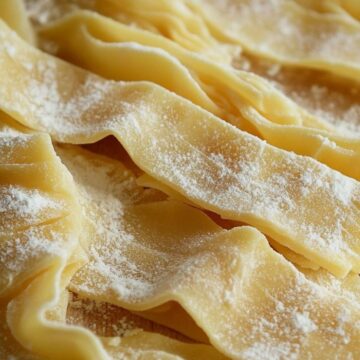There’s something incredibly satisfying about making Homemade Egg Noodles from scratch. I remember the first time I rolled out dough in my kitchen, feeling both nervous and excited. The process turned out to be simpler than I expected, and the result? Absolutely delicious! These noodles are rich, tender, and perfect for soups, casseroles, or pasta dishes.
What I love most about this recipe is how versatile it is. Whether you’re serving them with a hearty beef stew, creamy alfredo sauce, or simply butter and herbs, these noodles always deliver. They’re also freezer-friendly, so you can make a big batch and enjoy homemade pasta anytime. Let’s dive into this easy 5-ingredient recipe and bring the magic of fresh pasta to your table!
Why You’ll Love This Recipe
- Only 5 ingredients: Simple pantry staples make this recipe accessible for everyone.
- Fresh and flavorful: Homemade noodles have a richer taste and better texture than store-bought.
- Customizable thickness: Roll them thick for hearty soups or thin for pasta dishes.
- Freezer-friendly: Make ahead and freeze for quick, homemade meals anytime.
- Perfect for beginners: No special equipment needed—just a rolling pin and a knife.
Recipe
Ingredients
- 1 large egg
- 2 egg yolks
- 3 tablespoons cold water
- 1 teaspoon salt
- 2 cups all-purpose flour
Directions
- Mix Wet Ingredients:
- In a medium mixing bowl, whisk together the egg, egg yolks, and cold water until smooth and well combined.
- Add Dry Ingredients:
- Stir in the salt and gradually add the flour, mixing with a fork or spoon until a rough dough begins to form.
- Knead the Dough:
- Transfer the dough to a lightly floured surface. Knead it by hand for 8–10 minutes until the dough becomes smooth and elastic.
- If the dough is too sticky, add more flour 1 tablespoon at a time. If it’s too dry, add a few drops of water.
- Rest the Dough:
- Wrap the dough in plastic wrap and let it rest at room temperature for 30 minutes. This helps relax the gluten, making it easier to roll out.
- Roll Out the Dough:
- Divide the dough into 2 portions for easier handling.
- Roll each portion into a thin sheet (about ⅛ inch thick) using a rolling pin. For thinner noodles, keep rolling until desired thickness is achieved.
- Cut the Noodles:
- Use a sharp knife or a pasta cutter to slice the dough into thin strips for noodles. Adjust the width based on preference—thin for soups, wider for fettuccine-style pasta.
- Dry Slightly (Optional):
- For firmer pasta, let the noodles rest on a floured surface or drying rack for 15–20 minutes before cooking.
- Cook the Noodles:
- Bring a large pot of salted water to a boil.
- Add the noodles and cook for 2–3 minutes or until tender but firm. Fresh noodles cook quickly, so keep an eye on them.
- Drain and serve immediately with your favorite sauce, soup, or butter.
Serving and Storage Tips
- Serving Suggestions: Pair these noodles with hearty soups like chicken noodle soup, creamy pasta sauces, or simple garlic butter with fresh herbs.
- Storage: Store uncooked noodles in an airtight container in the refrigerator for up to 2 days.
- Freezing Option: Freeze uncooked noodles in a single layer on a baking sheet, then transfer them to a freezer-safe bag. They can be cooked directly from frozen—just add 1 extra minute to the cooking time.
- Leftovers: Cooked noodles can be refrigerated in an airtight container for 3–4 days. Reheat by tossing them in a pan with a little butter or sauce.
Helpful Notes
- Flour Alternatives: Swap all-purpose flour with whole wheat flour for a nuttier flavor or semolina flour for a more traditional pasta texture.
- Egg Alternatives: Add an extra egg yolk instead of the whole egg for richer noodles, or reduce the yolks for a lighter dough.
- Thickness Control: Use a pasta machine for even rolling if you prefer thinner noodles.
- Flavor Variations: Add herbs like parsley or garlic powder to the dough for an aromatic twist.
- Salted Water for Cooking: Always salt the boiling water generously to enhance the flavor of the noodles.
FAQs
- Can I make these noodles without a pasta machine?
Yes! Just roll the dough thinly with a rolling pin and cut with a knife. No special tools are required. - How can I make the noodles even softer?
Add 1 more egg yolk for extra richness and softness. - Can I dry the noodles completely for later use?
Yes, let them air-dry for 24 hours until completely firm, then store in an airtight container for up to 1 month. - Can I use gluten-free flour?
Yes, but you may need to add a binding agent, such as xanthan gum, to maintain elasticity. - How do I make flavored noodles?
Incorporate spinach puree for green pasta, tomato paste for red pasta, or beet puree for pink pasta when mixing the wet ingredients.
Final Thoughts
Homemade egg noodles are a classic comfort food that’s surprisingly simple to prepare. Once you try this recipe, you may never go back to store-bought pasta again. With just 5 basic ingredients, you can create fresh, flavorful noodles that work beautifully in soups, creamy sauces, or buttered side dishes.
I love the versatility of this recipe—you can make them thick for hearty stews, thin for delicate pasta dishes, or even shape them into squares for homemade dumplings. Plus, they freeze beautifully, so you can always have a stash ready for quick meals.
If you’ve never made pasta from scratch, this is the perfect recipe to start with. It’s forgiving, beginner-friendly, and yields delicious results every time. Give it a try and enjoy the satisfaction of homemade noodles that taste as good as they look!

Homemade Egg Noodles
Ingredients
- 1 large egg
- 2 egg yolks
- 3 tablespoons cold water
- 1 teaspoon salt
- 2 cups all-purpose flour
Instructions
Mix Wet Ingredients:
- In a medium mixing bowl, whisk together the egg, egg yolks, and cold water until smooth and well combined.
Add Dry Ingredients:
- Stir in the salt and gradually add the flour, mixing with a fork or spoon until a rough dough begins to form.
Knead the Dough:
- Transfer the dough to a lightly floured surface. Knead it by hand for 8–10 minutes until the dough becomes smooth and elastic.
- If the dough is too sticky, add more flour 1 tablespoon at a time. If it’s too dry, add a few drops of water.
Rest the Dough:
- Wrap the dough in plastic wrap and let it rest at room temperature for 30 minutes. This helps relax the gluten, making it easier to roll out.
Roll Out the Dough:
- Divide the dough into 2 portions for easier handling.
- Roll each portion into a thin sheet (about ⅛ inch thick) using a rolling pin. For thinner noodles, keep rolling until desired thickness is achieved.
Cut the Noodles:
- Use a sharp knife or a pasta cutter to slice the dough into thin strips for noodles. Adjust the width based on preference—thin for soups, wider for fettuccine-style pasta.
Dry Slightly (Optional):
- For firmer pasta, let the noodles rest on a floured surface or drying rack for 15–20 minutes before cooking.
Cook the Noodles:
- Bring a large pot of salted water to a boil.
- Add the noodles and cook for 2–3 minutes or until tender but firm. Fresh noodles cook quickly, so keep an eye on them.
- Drain and serve immediately with your favorite sauce, soup, or butter.
Notes
- Flour Alternatives: Swap all-purpose flour with whole wheat flour for a nuttier flavor or semolina flour for a more traditional pasta texture.
- Egg Alternatives: Add an extra egg yolk instead of the whole egg for richer noodles, or reduce the yolks for a lighter dough.





